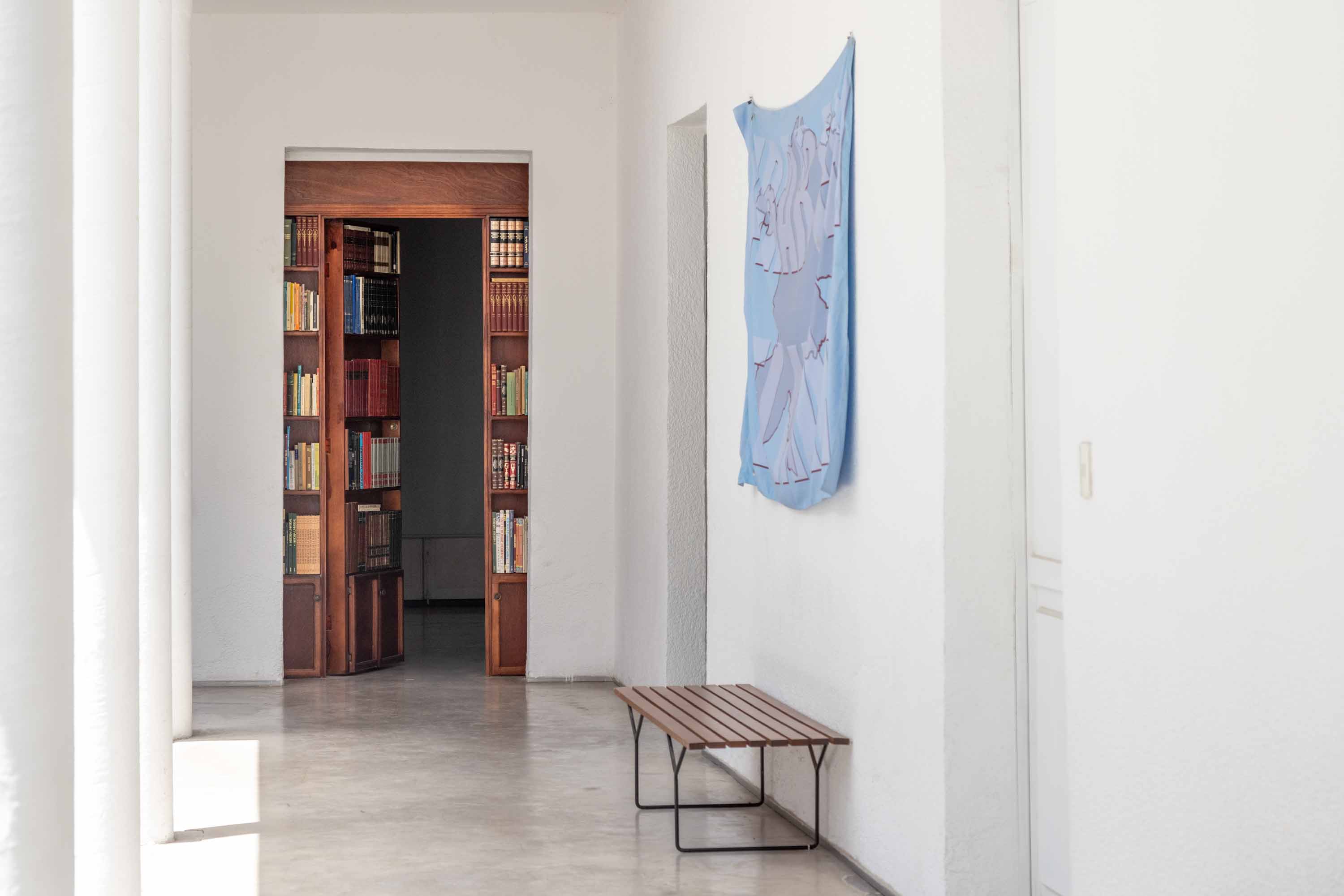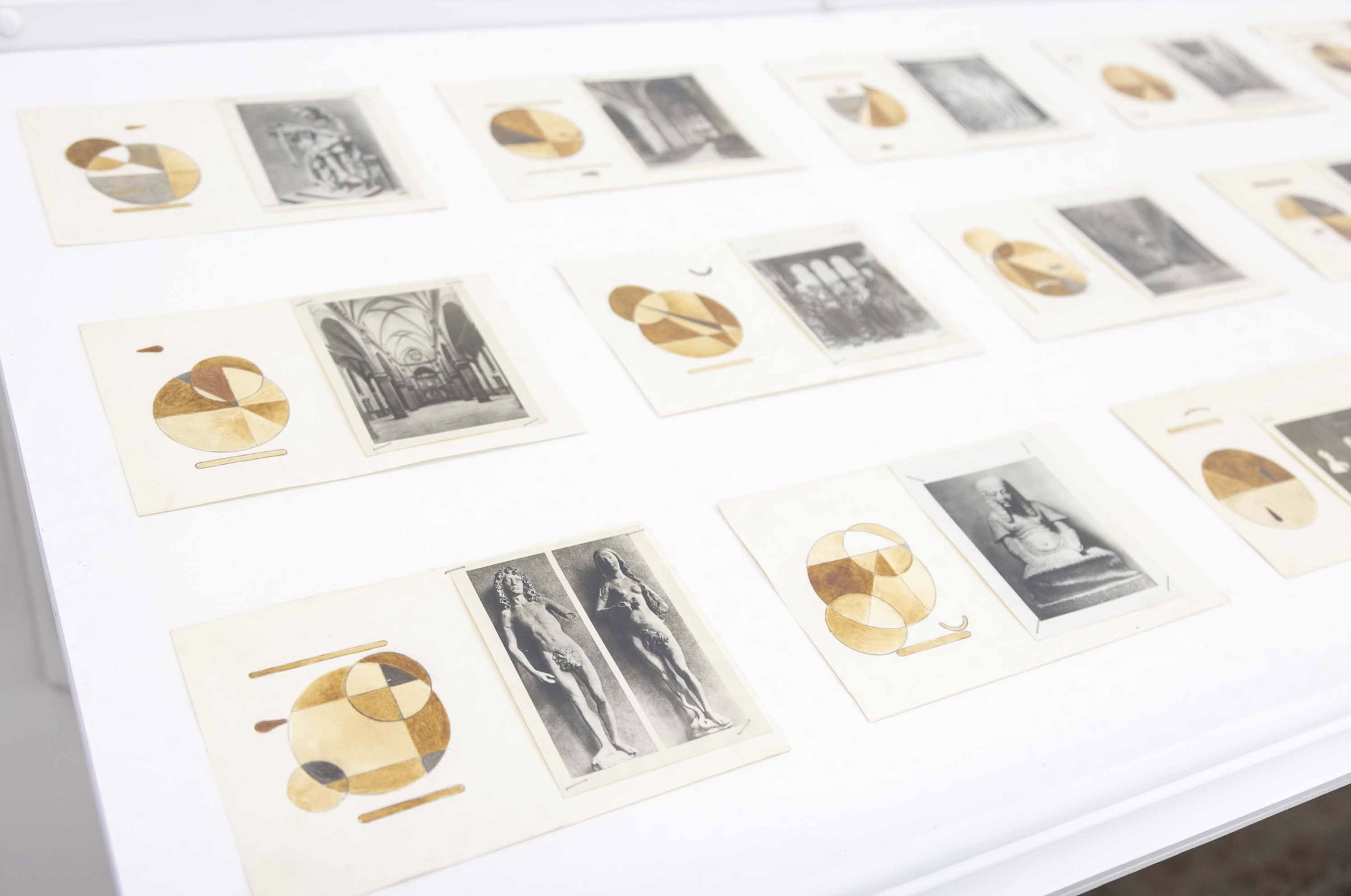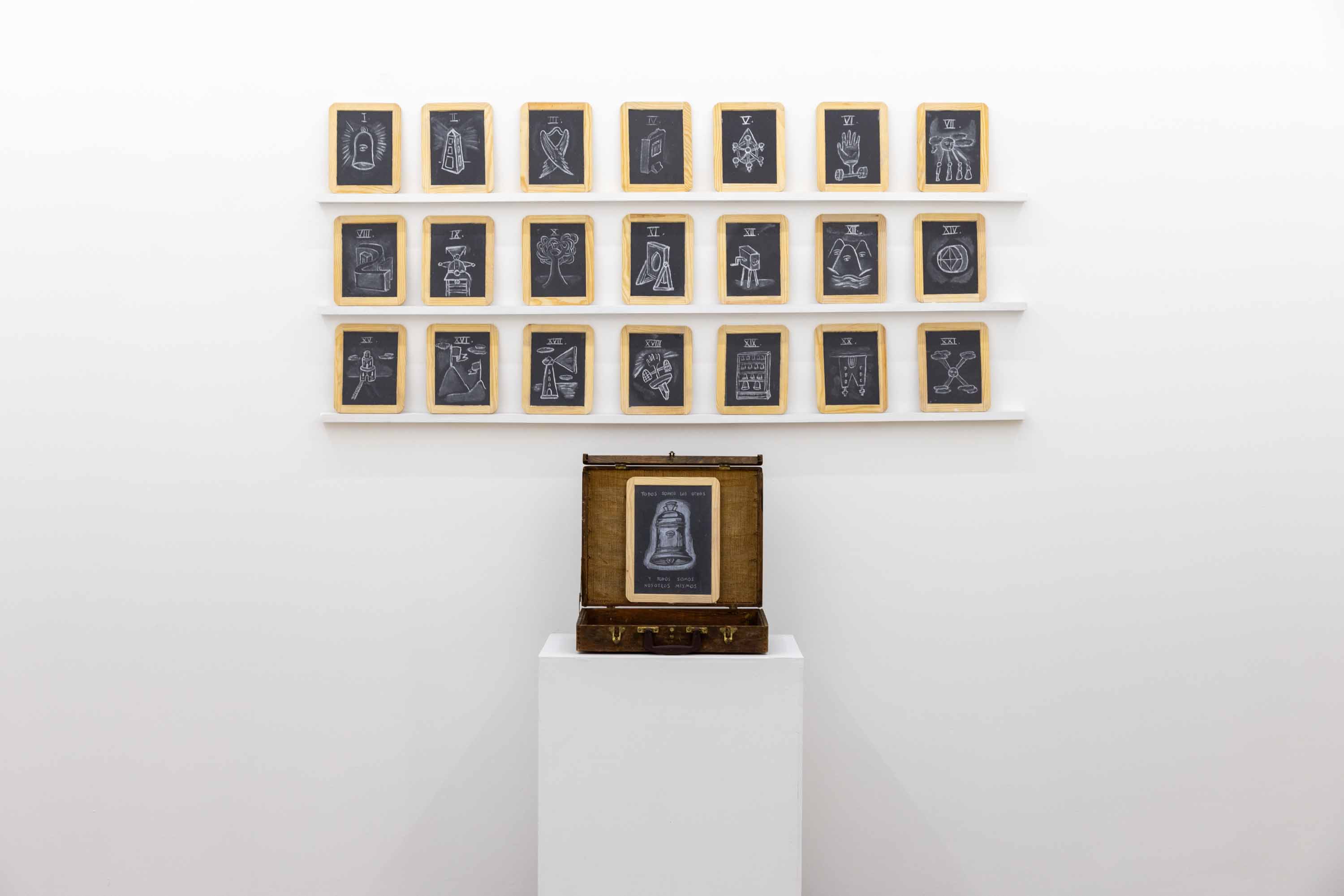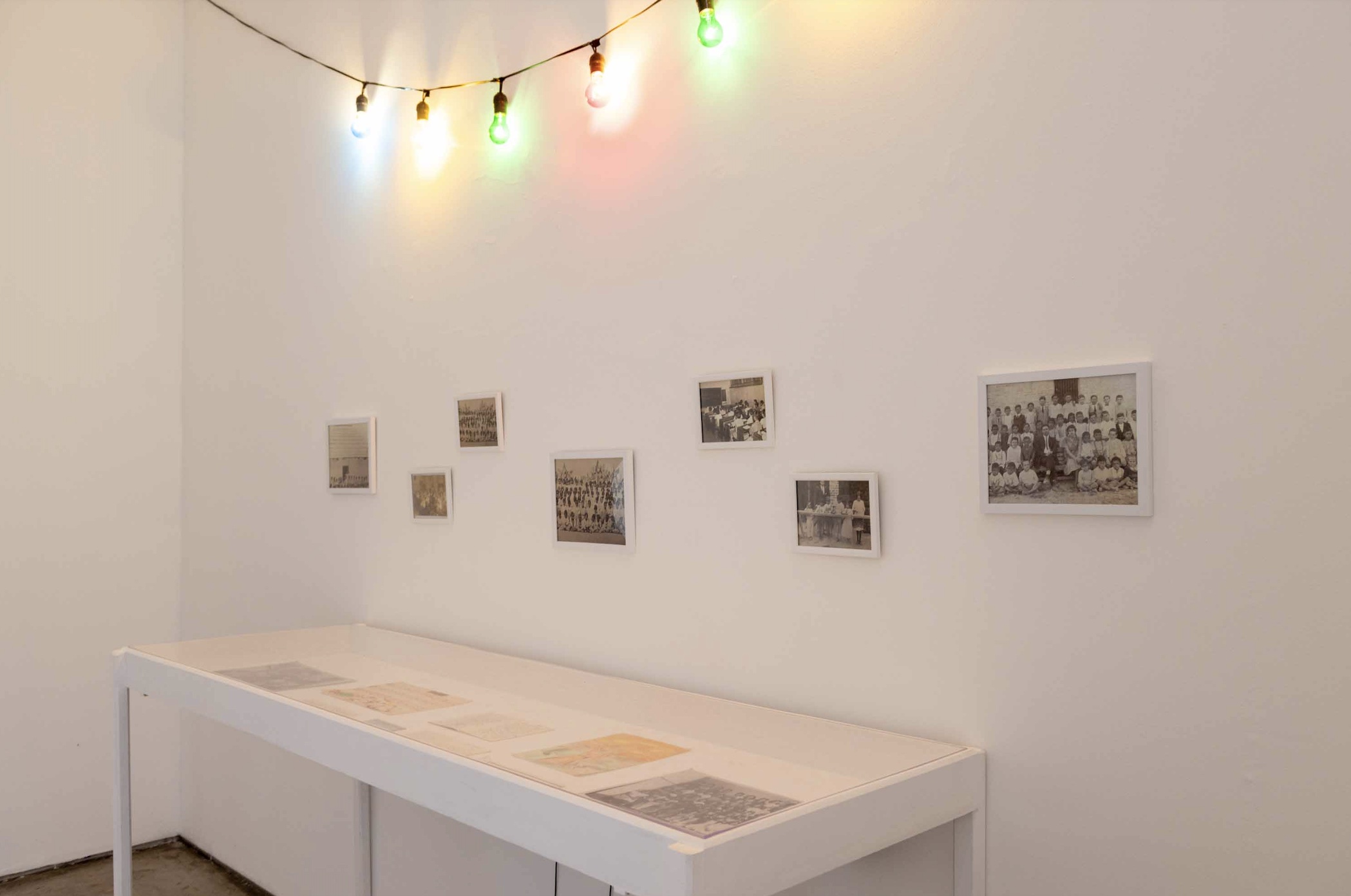
Essay
The museum as a suitcase: Pablo Helguera at Galería Enrique Guerrero
by Sandra Sánchez
Reading time
7 min
What do we see when we look at a work of art? Historian Erwin Panofsky tells us that everyone is free to see what they want; he called this pre-iconography. Everyone except the historian, whose iconographic duty is to investigate primary and secondary documents to discover the true (and universal) meaning of the artwork, as well as to place it iconologically within its social context.
Artist and educator Pablo Helguera destabilizes this premise. Michel Foucault also addressed it when he denounced that the visible cannot be reduced to the enunciable, and vice versa. Panofsky (and modernity) fail: life, image, and becoming cannot be reduced to a logical statement without aporias.
What is the basis for the universality of the artwork? It lies in reducing it to the meaning of the motifs it contains and their thematic relationships, which have historical meanings. Studying motifs is all well and good, but the problem arises when we think that the artwork is limited to the investigation of these meanings, where everything is neatly tied together. As if its purpose were purely epistemological; devoid of enigmas, emotions, sensations. A position where not knowing generates panic because control is lost. An infinite debt of the image to the sign, as if everything about something could be known.
In his exhibition Museum of School Life at the Enrique Guerrero gallery, Helguera begins to dismantle the relationship between artwork and meaning from the start. Umbral [Threshold] (2023) is a bookshelf that serves as a door where books are not read, but traversed. What does it entail to physically go through a book? For me, it brings to mind Alice in Wonderland, an encounter with delirium and fantasy, where language is not canceled but begins to flow into sensation, imagination, and beyond the surface. Vibrations. Encounters. I might not read all the books in my personal library, but they comfort me; they are there, and I feel protected.

Gardener's Art Through the Ages at 3 a.m. (2023) consists of horizontal sheets divided in two and arranged in a grid. On each sheet, one side features a circular diagram made with different dilutions of coffee, and on the other side, an artwork. They resemble postcards. It is inevitable not to fall into the temptation of trying to decipher the code that connects the diagrams to the images. However, whether or not such a code exists, what it demonstrates is the immediacy with which we want to solve the puzzle rather than observe the puzzle itself. Pablo says the piece is based on his experience as an art student at the Art Institute of Chicago, where he used Helen Gardner's book Art Through the Ages to memorize titles, authors, years, and techniques of the artworks during long nights, coffee in hand.

In my classes, I tell my students that to write about art, one must attempt to approach their own desires. Do not take the gaze for granted; understand that it is personal and simultaneously a construction made consciously and unconsciously to fulfill a series of expressible and ghostly demands. We delve deeply into Lacan, Deleuze, trying to stop thinking that merely opening our eyes results in seeing, or that there is a correct, well-thought-out, natural way of seeing. Following Didi-Huberman, I tell them that looking is taking a position.
I think about this when I see Valija Panamericana (2003), a suitcase with cards holding drawings made with chalk, which was part of La escuela panamericana del desasosiego [The Pan-American School of Disquiet]. Helguera traveled from Alaska to Chile with the suitcase, along the Pan-American Highway, organizing workshops and actions to explore Pan-Americanism. The icons did not dictate the narrative but initiated the conversation. Besides the experience, which is irreducible to the object, I am interested in the chalk icon as a threshold, a pass, a means to dialogue on how to take a position. A sign used not to fix a meaning but to perform a practice among many.

Finally, the last piece I want to write about is the sound installation Museo de la vida escolar [Museum of School Life] (2016), which includes the text Enredadera [Vine] (1992). Large colorful lights, reminiscent of Stranger Things, illuminate a table displaying childhood drawings, report cards, and teacher's reports. While we observe this, we hear Helguera's voice telling us about his life, about the girl he liked: he says he waited for her after school... and she left, and the others left, and he couldn't confess his love to her. He also talks about a garden, about his sensations there and at school. I love this piece because it creates a space for each person to revisit their childhood and their school life. It is a reminder that learning is a collective act, full of sensations, memories, and desires. That school is a way of relating to others, a place of memory archaeology, as well as a system for organizing the world.

Is life (school life) like a museum? I don't know. I have a multifaceted proximity to the museum. Its relationship with artworks weighs heavily on me (quite like Panofsky). Its lack of questioning regarding the relationship with knowledge, condensed into long technical sheets for viewers to understand the artworks, irritates me. Its modern discursive formation annoys me: neat, well-thought-out, logical... ultimately moral: in its faith in knowledge. That it will make us good people. Not all museums, of course. Not all the time, of course. But most of the time.
This drift reminds me of Triángulo [Triangle], a performative practice I collaborated on with Bárbara Foulkes at the Museo Jumex this year. One person imitated the ways a spectator sees, trying not to be discovered, while someone else watched the spectator and the imitator, taking notes on what they saw. Differing the gaze, seeing how it is a collective practice... both for critical dismantling and for fascism.
The museum as a school? Perhaps yes, but not in that hateful relationship between technical sheets and artworks, not in reducing art to its iconography. Perhaps yes, but as a curatorial possibility to experiment with narratives through the assembly and disassembly of objects and knowledge. As a meeting place with discourse, but not without its enigmas. As a space for questions, for mystery. And here, the word "space" is important. Because space opens up to the body and to others. A place to have a place in relation to. Without the relationship pre assigning the places. A museum, yes, but where the school is understood as a space for improvisation.
I can't stand seeing a table in a museum with documents under glass legitimizing an untouchable and inscrutable knowledge (and the hard work—irrelevant to the viewer—of the historian). The archive, yes, but as an opening, as a threshold that is crossed. Not as interpretation but as intervention. Listening is intervening. Seeing-listening.
My friend Guille says we should think about an image, the one we keep in our shirt pocket close to our heart. A work of art will never be a substitute for the realness of a loved one, but Guille's idea opens up a space that I think interests Helguera and me as well. That a work enlivens movements and circulates conversations like when we take out that photo from our pocket and tell someone why we carry it with us. And history? Not renouncing motifs and archives, but stopping thinking they are universal, that while there are meanings that persist diachronically, these meanings are always updated in specific communities, in peculiar urgencies. In affections and bodies. In performances and silences (sometimes there are works that have nothing to say to us, for now, and that's fine). The artwork alongside other artworks in a suitcase that will be opened to start the conversation. The museum as a suitcase.
Translated to English by Sebastián Antón-Ojeda
Published on October 27 2023